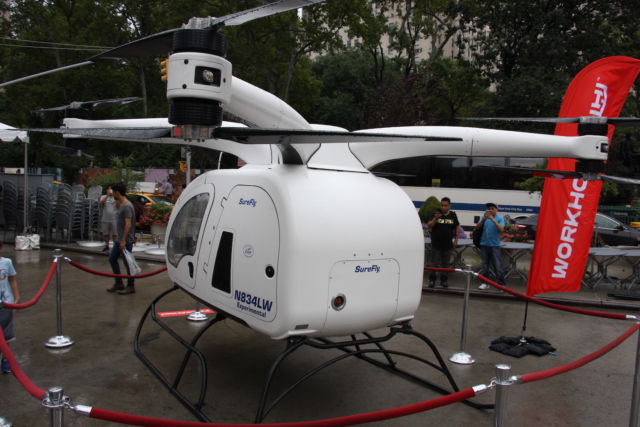Workhorse brings an electric pickup truck, helicopter to Manhattan
Workhorse, with its 120 employees, hopes to beat larger players to market.
I wasn’t sure entirely what I expected an electric helicopter to look like, but what I found waiting for me at New York’s Flatiron Plaza wasn’t it. It’s not because it didn’t look like a helicopter; to an extent, it did. It just looked more like a grossly oversized drone with seats.
Workhorse, the company that makes the helicopter, wasn’t giving anyone rides in the hardware, which is still undergoing FAA testing. But company CEO Steve Burns was there to talk about the ‘copter, which is being called the SureFly. And, for good measure, he also showed off an electric pickup truck, which went by the less dramatic monicker W-15.
If pickup trucks and helicopters seem largely unrelated, it’s only because they’re at opposite extremes of the company’s business interests. Workhorse is currently building electric delivery vans and testing one with a drone-based delivery system integrated into the van roof. (During our conversation, Burns mused about the prospect of using a drone to deliver burgers from a nearby Shake Shack to a 25th-floor balcony on one of the buildings that overlooked the plaza.) So both are in keeping with the company’s interests.
Going up?
But a helicopter is a big step up from a drone. “Why now?” Burns asked, preempting the obvious question. “The building blocks are all there.” In fact, the power systems of the helicopter and pickup truck are based on identical principles—ones that have reached the mass market in forms like the Chevy Volt. Even though the helicopter is electric, it’s not battery-powered. Instead, its battery acts as an emergency backup in case of a failure of its primary source of electrons, a small diesel generator.
That approach is what allows the SureFly to achieve a lot more flight time than all-battery helicopters, which typically max out at about 20 minutes. The SureFly can stay airborne for roughly an hour. The electric power system also allows the helicopter to lose its large central blade and tail rotors while gaining a drone-like configuration of four arms that end with two counter-rotating propellers.
Burns told Ars that the onboard electronics in the helicopter can control each of the propellers individually and make adjustments thousands of times a second. They’re what allow the SureFly to remain stable even if it’s got a heavy pilot on one side and no passenger on the other, which forces the pilot-side propellers to work much harder. The configuration also provides some redundancy, as Burns said that the SureFly can still fly after losing one propeller per arm.
The counter-rotation also cancels out the forces generated by the rapidly rotating blades, which eliminates the need for the tail rotor (Burns said getting rid of the tail can cut the overall energy use by up to 20 percent). To yaw, or rotate around horizontally, the controllers simply slow down one set of blades and speed up the other, generating forces that twist the SureFly around.
While the electronics are quite sophisticated, the control systems are relatively minimalist. There’s nothing like the wall of gauges found in traditional aircraft. In fact, there’s nothing in front of the pilot. The cockpit just has seats, a traditional control stick, and a tablet. The minimalism is one of the things that keeps the SureFly under 800kg (1,700 lbs)—which in turn allows up to 180kg (400 lbs) of payload, whether that’s people or baggage.
Down to Earth
The W-15 is at the other end of Workhorse’s spectrum of interests, and it’s aimed squarely at the mainstream. Burns pointed out that pickup trucks are the number-one selling vehicle type in the US, and there isn’t an electric pickup on the market yet. Workhorse decided to go with a proven approach on the W-15: enough battery to last 80 to 100 miles on electric alone and a small gasoline engine that can drive a generator to extend the range indefinitely. Workhorse has sourced the engine from BMW and its battery cells from Panasonic.
Like the SureFly, the W-15 is all carbon fiber to keep it light. But that doesn’t mean it can’t be made heavy; it can handle more than 1,100kg (2,500 lbs) of cargo and can tow more than 2,700kg (6,000 lbs).
Right now, Workhorse is hoping to sell these trucks to companies with large fleets (Burns said Duke Energy is an early purchaser). Avoiding the consumer market lets them keep things simple, offering only a single color and options package. Despite having only 120 employees right now, Burns says Workhorse intends to be able to produce 30 of the pickups a day by the end of next year. Helicopter production will have to wait for FAA approval.

